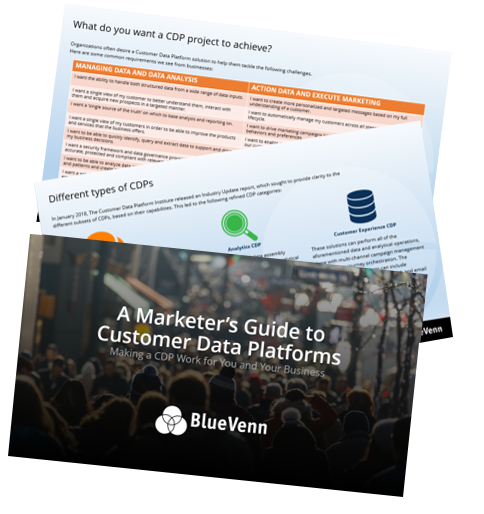
Data privacy is a hot topic these days, with the General Data Protection Regulation (GDPR) enforcing stricter guidelines for the use of personal data for EU citizens and the forthcoming California Consumer Privacy Act (CCPA) offering stringent powers to consumers who feel that their personal data has been misused.
These data management regulations, and similar laws in countries like Australia, Japan and Brazil, are starting to put pressure on organizations to establish systems and processes that demonstrate the responsible use of customer data.
A strong use case for a Customer Data Platform (CDP) is to mitigate the risks associated with such regulations, which could ultimately result in a hefty fine in the event of a breach. A CDP will ingest customer data from existing systems and databases, then structure, standardize and normalize it into meaningful information, and unify all data held on specific customers, or unknown individuals, into single profiles. To be recognized as a ‘RealCDP’, the Customer Data Platform must be able to:
 ingest data from any source
ingest data from any source- capture full detail of ingested data
- store ingested data indefinitely (subject to privacy constraints)
- create unified profiles of identified individuals
- share data with any system that needs it.
Of these five capabilities, the most critical to lawful data management is that the CDP must “store ingested data indefinitely (subject to privacy constraints)”. As well as enabling organizations to analyze customer trends over time, this indefinite storage, in combination with the logging any changes to the data, provides conclusive evidence of where the data came from originally, how it has been used since, what type of data is held, how it has been enhanced or changed, and how it has been used for marketing.
Some CDPs, though, take this data management one step further. Having a User Interface (UI) in place can allow non-technical marketers to produce Subject Access Requests (SARs) at the touch of a button, erase Personally Identifiable Information (PII) on request, or conceal it when sharing records with third parties. In other words, the UI allows users to directly process and manipulate the data held in the CDP.
Putting the marketing team – and your customers – in full control of customer data

When it comes to proving consent for marketing and managing your customers’ preferences, a Customer Data Platform will act as the central repository to store all opt-ins and opt-outs, contact points and channel preferences, and will timestamp every stage of the customer’s data life-cycle.
Every change to the data, interaction and purchase is consolidated into a Single Customer View, allowing marketers to share or use that data freely. The core use case for a CDP isn’t usually compliance, but the nature of the way the platform stores and structures data makes compliance considerably easier.
When data is scattered across many systems and silos, it becomes much more difficult to efficiently generate an SAR. Plus, if you experience a publicized data breach, necessitating the potential provision of tens of thousands of them, the process becomes nearly impossible to manage, especially within the prescribed time constraints. Being able to access the Single Customer View takes the headache out of the job.
Since it already stores all your customers’ preferences in one place, it makes sense that a Customer Data Platform should provide its users with the tools to manage these preferences and act upon the regulatory demands of the GDPR and the CCPA. Why not add a button to produce an SAR, erase data, or package it for portability to a new system?
For that matter, why not provide direct access to the data within the CDP by enabling businesses to create a secure, unique web form that enables a customer to manage their preferences, choose what subjects they do and don’t want to hear about, select how often they want to receive communications, or totally unsubscribe if they wish to?
For ‘right person, right message, right time’ and right device marketing, the only true way to ensure you create perfect 1-2-1 relationships is to let the customer dictate their preferences. By using your CDP to power a multi-channel preference center, you can make this possible.
The BlueVenn Unify Multi-Channel Preference Center
BlueVenn has recently added a new Multi-Channel Preference Center module to our Unify Customer Data Platform. Rather than using your email or marketing automation platform to handle preferences (digital-only preferences usually), you can therefore use the CDP. It enables a more holistic and multi-channel approach to preference management by exposing all your customers’ online and offline preferences, for all marketing communication channels, and then acting as the master data handler, ensuring that their choices are respected and activated across your marketing channels.
Offering this control is the ideal way to ensure that your marketing campaigns will be received favorably, and will also allow you to better personalize the interactions you have with each customer.
With the CCPA on the very near horizon, customer data management and use of personal data is firmly at the front of businesses’ minds again. If you want to show that your organization is using customer data in an optimized way, structuring it efficiently and responsibly, and respecting your customers’ rights, then a CDP with a built-in multi-channel preference center is the answer.
Want to know more? Download the ‘Marketer’s Guide to Customer Data Platforms’ eBook

Download a copy of the ‘A Marketer’s Guide to Customer Data Platforms’ eBook to gain CDP advice, learn how a CDP differs from other data management technologies, or discover different types of CDPs and what to look out for when researching technology vendors.









